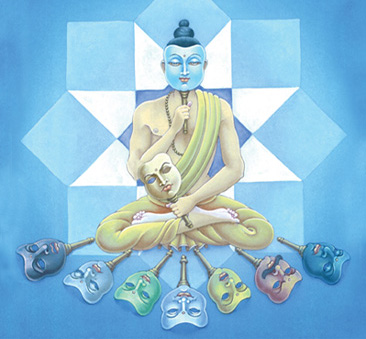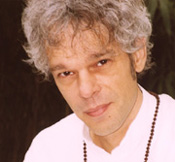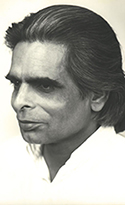Tantric Advaita |
 The nine Rasas are age-old vedic emotional categories, that are the essential aspects or energies that define a set of emotions and moods that thus belong to the same "family" or Rasa. While the nine Rasas themselves are clearly defined energies affecting body and mind, the resulting emotions (Bhavas) manifest in many varieties and their understanding is affected by personal and cultural backgrounds. Knowing the nine Rasas helps us understand why a certain mood comes and stays even though it's original cause may be long gone, as well as how to use that knowledge in achieving more emotional control.
The nine Rasas are age-old vedic emotional categories, that are the essential aspects or energies that define a set of emotions and moods that thus belong to the same "family" or Rasa. While the nine Rasas themselves are clearly defined energies affecting body and mind, the resulting emotions (Bhavas) manifest in many varieties and their understanding is affected by personal and cultural backgrounds. Knowing the nine Rasas helps us understand why a certain mood comes and stays even though it's original cause may be long gone, as well as how to use that knowledge in achieving more emotional control.
Rasa Sadhana is an ancient Tantric tradition of emotional fasting. We promise ourself that for a day or a week or longer we will not get involved with one of the less desirable Rasas or will fully focus on one of the more agreeable Rasas. When doing Sadhana of Anger for example, whenever some irritation comes, just remembering our promise not to give in to Anger will create a distance between us and the angry feeling. That is often enough to dissolve the anger and if not, other tricks can be used to help dissolve it. Through such regular exercise, we learn that we really can master our nine Rasas, which after some time will happen quite effortlessly. In order to perform this Rasa yoga, we need to understand what Rasas are and how each Rasa functions.
The Tantric tradition recognizes nine Rasas that relate to quite clearly defined basic moods or emotions (click the individual Rasas for more details) :
Sanskrit Term |
Principal Meaning |
Further Meanings & related emotions |
All desires for ownership, security, enjoyment, recognition, love, knowledge, enlightenment, etc. are all desires for the happiness that we hope to feel by fulfilling them. We desire the happy feeling to own, to be secure, to be recognized as somebody valuable, to enjoy, to Love, to know. Feeling happy Rasas is all that we ever really desire. Should happiness then not be pursued more directly and durably ? That is the essential objective of Rasa Sadhana. Stop being unhappy and enjoy your happiness in a way that does not lead you back to unhappy Rasas.
 |
The Nine Rasas or Emotional Essences |
Rasas and body/mind
Our Rasas or essential emotions are the main link between body and mind. They largely determine the impact of body chemistry on our thinking mind and how our thoughts affect our health.
Rasas or the essences of our emotions are neither purely physical nor purely mental. Bad body chemistry creates disagreeable emotions and a healthy body offers the basis for more happy emotions. When a disagreeable Rasa catches us for a long period, the biochemical environment created in our body is difficult to get rid of and may lead to disease. Maintaining an agreeable Rasa over a long period will stabilize it, keeping our body healthy and curing disease.
According to the science of Ayurveda, the emotions that affect our mind through the Rasas relate to: the five basic elements; the three doshas (humors or temperaments); the three gunas (energy qualities of nature); the seven dhatus (constituents of the human body); the five senses; food; and prana (the vital life force).
Modern Western knowledge primarily has value in demonstrating the connection between body, mind and emotions. It mostly concentrates on complex mixtures of neurotransmitters and other information molecules that affect our emotions and mind and are affected by them. The approaches of Yoga, Tantra, and Ayurveda offer much more practicle insight about how to really work with our emotions through our body and vice versa.
Neurotransmitters and other information molecules are the molecular equivalent of Rasas. The main task of nerve cells is to transfer messages as electric pulses to other nerve cells in our brain and body, using channels called dendrites and neurites. These are extremely thin, thread-like "branches" that connect every nerve cell to other nerve cells. Between them there are spaces known as synapses, which are filled with the cerebrospinal fluid in which all brain tissue is embedded. The electric pulse that is sent from one nerve cell to another does not simply flow through this fluid. The transfer of the information in the electric pulse happens with the help of molecules in the cerebrospinal fluid called neurotransmitters. These neurotransmitters absorb and pass on the information.
Neurotransmitters are also essential in the transfer of information from nerve cells to other body cells and vice versa. To read the information contained in these neurotransmitters, all body cells have "receptor molecules," attached like long antenna to the outside of their cellular bodies. Neurotransmitters, receptor molecules, and substances that affect them are today grouped as "information molecules."
One of the most fantastic findings of modern science is that we are continuously creating new connections between brain/nerve cells. Our emotions and thinking thus continuously create new neural patterns, pathways of communication between parts of the brain and also of the body. Thus, reprogramming our brain has never been science fiction - it happens all the time. Every neural pattern also reflects as a biochemical pattern in our body. Such a pattern consists of particular mixtures of information molecules spread throughout specific parts of the body. Rasa Sadhana offers a clear method to effectively change these emotional, neural, and biochemical reaction patterns.
Rasas in Art
The central objective of classical Indian art and drama is to create Rasa in the spectators, in order to communicate or suggest a kind of knowledge that cannot be clearly expressed in words. Thus art becomes a means for educating and healing emotion.
Only pure beings create pure art with pure emotion. Through the application of Rasa Sadhana to his or her own life, an artist may master all of the Rasas, and thus purify his or her aesthetic sense to such a degree that the art produced also becomes pure in emotion.
Classical Indian art will try to cover all Rasas found in life, but will focus on the most desirable Rasas. Less agreeable Rasas may also enter Indian art, but mostly to create the contrast that makes the agreeable Rasas even more powerful.
Using new ways to create art, new media, and new techniques is fantastic. In order to remain interested, both spectators and artists need variation. Abstract art can be just as effective in evoking Rasas as other art, as is also demonstrated by the ancient use of yantras (geometrical patterns).
In modern times, the artist gives an expression of how society has gone away from wholeness. Naturally, less agreeable Rasas such as Fear, Sadness, Anger, and Disgust have become more dominant in modern art. Unfortunately many artists are so absorbed by the less desirable Rasas that they create art purely out of these negative emotions. The expression gives them some kind of satisfaction and such art may also naturally attract attention because it is seen as innovative (Adbhuta) and courageous (Veera). In order to satisfy their public, they always need to find new ways to be remarkable by delving deeper into their darkest emotions, which makes them suffer personally.
Rasas and food
Tantra and Ayurveda regard the blood plasma, fed by food, as the principal promotor of happy feelings. The seven dhatus are the principle constituents of the body, literally the "body tissues." They need nourishment and give form to the physical body. Rasa as plasma or "nutritive juice" is the most essential dhatu that is derived from food, and all other dhatus are derived from it. The plasma is the watery solution that carries the free chemicals in our blood, among which are the neurotransmitters and many substances that affect neurotransmitter activity. The science of Ayurveda regards plasma as both the carrier of essential nourishment and the promoter of happiness.
According to Ayurveda, foods affect our emotions through the direct effect of taste (rasa), through the effect during digestion (virya), and the effect after digestion (vipaka). The resulting doshas and gunas stimulate the occurrence of particular Rasas. Thus all foods are moodfoods.
Some foods may have toxic effects on our emotional well-being. Meat is emotionally toxic primarily because it contains large amounts of neurotransmitters created by the fear and pain of the dying animal. Eating organic foods is another way to avoid emotionally toxic substances.
Bad digestion means that many toxins are being produced inside the intestines. The organs of the digestive system are heavily loaded with receptors as well as production centers for information molecules that affect our emotions without our being conscious of it.
"Moodfoods" - as foods that have particularly high effects on the emotions - are becoming more and more popular. There is nothing wrong with eating in accordance with this approach as long as it is applied honestly and in moderation. Ayurvedic knowledge regarding the effects of specific moodfoods may be used to control specific Rasas, keeping in mind that such an approach is absolutely secondary to eating properly balanced food.
Many moodfoods give people the idea that happiness can be bought. The stronger these mood products become, the more they contribute to the creation of a culture of drug addiction. The use of antidepressants, calming agents, and stimulating agents is already extremely high in Western society, even though it is often legally limited to prescription by doctors. Less powerful mood products and moodfoods easily escape legal prescription, leaving the doors wide open for abuse. Products that are designed to alter moods (as all products are, even without their makers being conscious of it) should be really mild.
Rasa Sadhana
If you want to be happy, stop being unhappy. We can be slaves of our Rasas or not. Even if an unhappy mood also makes some sense sometimes, we have every right to be happy whatever happens and can develop the power to exercise that right.
Rasa Sadhana includes fasting from or on specific emotions. We usually first promise ourself that for a day or a week or longer we will not get involved with one of the less desirable Rasas, such as Anger, Fear, Sadness, or Disgust. When the emotion surfaces it will not be suppressed, but properly analyzed through our knowledge of the origin of the Rasa; that alone will render it largely powerless. With the aid of some specific techniques that often involve the body, the energy of the Rasa can be more fully dissolved. The promise made in the Sadhana will provide us with the will power to do so in any case, because to fail means to hurt the ego and when the ego gets involved the Rasa stands no chance.
For example, take the Anger Rasa. Anger is always based on some unfulfilled expectation. If we stop expecting things from others, then there is no more need for anger. When we realize that one minute of anger can kill the peace obtained through a long period of meditation, then we understand that getting angry turns a little problem into a really big one. If we stop getting irritated about other people's errors, we refrain from turning their problem into our own problem. It is another way of not letting them "win the fight". To refrain from Anger does not makes us defenseless neither. We are still able to communicate our position and may quite clearly show them that their incorrect behaviour may have consequences - that is called non-violent resistance. To do so in a calm manner may be a lot more convincing than an emotion-based threat. To reduce the Anger Rasa, literally cooling down our biochemistry can be a great help. And our Anger Rasa can also be countered by one of the enemy Rasas Humor, Love and Wonder. Especially Humor works miracles against angry thoughts, because it is also based on the Fire dosha.
When the less desirable Rasas have thus been brought under control, we can start fasting on the desirable Rasas, such as Peace, Love, Joy, Wonder, and Courage - staying in one of these moods for a particular time. Any Rasa Sadhana can also be adopted for a really long period or even for a lifetime.
Rasa Sadhana originated in the time before Hindu yogis started organizing themselves into more institutionalized akaras (schools) and ashrams (communities). Before that time, spiritual teaching happened in the gurukula, the family home of the teacher. These teachers were usually married and had children, so the teaching that took place connected directly to normal life.
Rasa Sadhana offers the householder an alternative spiritual path, which includes the Peace Rasa that is the most linked to yoga, but also teaches us how to find happiness and spiritual growth in the other Rasas. This Rasa fasting does not require stepping outside of social life, nor does it require any extra time investment. If we can remain free from disturbing emotions during the day, then the meditation that we are able to do will be much more fruitful. Prolonged Rasa Sadhana also brings certain special powers called siddhi's.
Depending on our biochemistry, personal preferences, and temporary problems or opportunities, we may choose which Rasa to exercise. It is important to clearly establish the rules of a particular sadhana, because otherwise the sadhana can be very destructive to one's self-confidence. It is advisable to keep it short in the beginning and gradually increase the duration.
Mastering our thoughts and feelings is a lot more difficult than mastering our words and actions. One may limit a sadhana to words and actions to begin with. But the Rasa will never be mastered if our thoughts and feelings are not mastered and it is often easier to attack the Rasa at the root, the original though-feeling.
Rasa Sadhana is not about suppressing emotions! Negative thoughts and emotions must be allowed sufficient expression for their origin to be properly analyzed. It is most of all this very analysis, which emphasizes the witnessing factor, that will dissolve any disagreable Rasa.
▶ Interview with Peter Marchand on Rasa Sadhana, published in the Integral Yoga Magazine (PDF)
 Leela is the ancient vedic name for the theater of life. Life in all its forms is an illusion behind which we can find the ultimate truth of pure Being. Yet life is also a divine theater, a spiritual game played by us, the actors. Yoga allows us to hold on to the bliss of truth while playing the game. And also this yoga is a game, which we can only take seriously if we do not take ourselves and this game too seriously. That is the meaning of Leela Yoga, nothing more, nothing less. So, Leela Yoga is a vision on yoga and also a name for a simple organisation that allows me to bring this vision into practice... more about Leela Yoga & Peter Marchand
Leela is the ancient vedic name for the theater of life. Life in all its forms is an illusion behind which we can find the ultimate truth of pure Being. Yet life is also a divine theater, a spiritual game played by us, the actors. Yoga allows us to hold on to the bliss of truth while playing the game. And also this yoga is a game, which we can only take seriously if we do not take ourselves and this game too seriously. That is the meaning of Leela Yoga, nothing more, nothing less. So, Leela Yoga is a vision on yoga and also a name for a simple organisation that allows me to bring this vision into practice... more about Leela Yoga & Peter Marchand
International Leela Yoga Facebook Group
Belgium : www.leela-yoga.be
New book : www.tantricadvaita.org
Harish Johari students sangha : www.sanatansociety.org
 |
in sweet memory of Harish Johari |
As the destination is the same for all, it is easy to make the error of assuming that the path must be just as universal.
The attachment that happens in the pursuit of happiness is the main source of unhappiness.
Don't think of going somewhere, because this somewhere will come along with you wherever you go, as you are already there.
Yoga requires unity between enjoyment and suffering, between bhoga and yoga, even between attachment and detachment.
How can anyone be "good" without a choice between good and bad?
While the mind creates the illusion of the universe through the senses, the intellect creates the illusion of understanding it.
When our day has been entirely ego-centered, then our meditation will probably have similar poor quality.
When the focus on the self is held strongly enough, the flow of kundalini energy happens on its own, naturally.
Tiptoe inside, don't make a sound, don't scare away that which cannot be found.
Enlightenment is nothing more or less than the final level of the game of life.